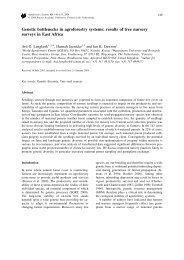A Phylogenomic Study of Birds Reveals Their Evolutionary History
A Phylogenomic Study of Birds Reveals Their Evolutionary History
A Phylogenomic Study of Birds Reveals Their Evolutionary History
Create successful ePaper yourself
Turn your PDF publications into a flip-book with our unique Google optimized e-Paper software.
REPORTSFig. 4. Our phylogeny differs from and agrees with previous classifications. We merged well-supported(>70% bootstrap values) monophyletic clades at the tips with the same ordinal designation across allthree classifications (e.g., 24 species called Passerines). Only higher relationships supported by bootstrapvalues >50% are shown. Colors are as in Fig. 2. Color bars to the right <strong>of</strong> the tree show membership inthree different classifications: Peters’ (25) (left), Sibley and Monroe’s(30) (middle), and Livezey and Zusi’s(13) (right). Black text within the bars indicates monophyletic orders in our phylogeny, whereas white textwithin the bars indicates nonmonophyletic orders. Ordinal name codes: ANS (Anseriformes), APO(Apodiformes), APT (Apterygiformes), ARD (Ardeiformes), BAL (Balaenicipitiformes), BUC (Bucerotiformes),CAP (Caprimulgiformes), CAS (Casuariiformes), CHA (Charadriiformes), CIC (Ciconiiformes), CLM(Columbiformes), COL (Coliiformes), COR (Coraciiformes), CRA (Craciformes), CUC (Cuculiformes), FAL(Falconiformes), GAL (Galliformes), GAV (Gaviiformes), GLB (Galbuliformes), GRU (Gruiformes), MUS(Musophagiformes), OPI (Opisthocomiformes), PAS (Passeriformes), PEL (Pelecaniformes), PIC (Piciformes),POD (Podicipediformes), PRO (Procellariiformes), PSI (Psittaciformes), RAL (Ralliformes), RHE(Rheiformes), SPH (Sphenisciformes), STH (Struthioniformes), STR (Strigiformes), TIN (Tinamiformes), TRC(Trochiliformes), TRO (Trogoniformes), TUR (Turniciformes), and UPU (Upupiformes).change dramatically, based on our phylogeneticstudy, and that our results will stimulatecomparative studies to address the growingnumber <strong>of</strong> questions regarding the evolution<strong>of</strong> birds.References and Notes1. J. L. Chojnowski, R. T. Kimball, E. L. Braun, Gene 410, 89(2008).2. J. Cracraft et al., in Assembling the Tree <strong>of</strong> Life,J. Cracraft, M. J. Donoghue, Eds. (Oxford Univ. Press,New York, 2004), pp. 468–489.3. P. G. P. Ericson et al., Biol. Lett. 2, 543 (2006).4. M. G. Fain, P. Houde, Evolution Int. J. Org. Evolution 58,2558 (2004).5. J. Harshman, in Reproductive Biology and Phylogeny <strong>of</strong><strong>Birds</strong>, B. G. M. Jamieson, Ed. (Science Publishers, Enfield,NH, 2007), pp. 1–35.6. C. G. Sibley, J. E. Ahlquist, Phylogeny and Classification<strong>of</strong> <strong>Birds</strong>: A <strong>Study</strong> in Molecular Evolution (Yale Univ. Press,New Haven, CT, 1990).7. A. Feduccia, Science 267, 637 (1995).8. S. Poe, A. L. Chubb, Evolution Int. J. Org. Evolution 58,404 (2004).9. J. W. Brown, J. S. Rest, J. Garcia-Moreno, M. D. Sorenson,D. P. Mindell, BMC Biol. 6, 6 (2008).10. A. L. Chubb, Mol. Phylogenet. Evol. 30, 140 (2004).11. J. Cracraft, J. Clarke, in New Perspectives on the Originand Early Evolution <strong>of</strong> <strong>Birds</strong>: Proceedings <strong>of</strong> theInternational Symposium in Honor <strong>of</strong> John H. Ostrom,J. Gauthier, L. F. Gall, Eds. (Yale Univ. Press, New Haven,CT, 2001), pp. 143–156.12. J. G. Groth, G. F. Barrowclough, Mol. Phylogenet. Evol.12, 115 (1999).13. B. C. Livezey, R. L. Zusi, Zool. J. Linn. Soc. 149, 1 (2007).14. M. van Tuinen, D. B. Butvill, J. A. W. Kirsch, S. B. Hedges,Proc. R. Soc. London Ser. B 268, 1345 (2001).15. G. Mayr, J. Clarke, Cladistics 19, 527 (2003).16. E. L. Braun, R. T. Kimball, Syst. Biol. 51, 614 (2002).17. D. P. Mindell et al., Syst. Biol. 48, 138 (1999).18. K. E. Slack, F. Delsuc, P. A. Mclenachan, U. Arnason,D. Penny, Mol. Phylogenet. Evol. 42, 1 (2007).19. F. Delsuc, H. Brinkmann, H. Philippe, Nat. Rev. Genet. 6,361 (2005).20. E. Jiménez-Guri, H. Philippe, B. Okamura,P. W. H. Holland, Science 317, 116 (2007).21. W. J. Murphy, P. A. Pevzner, S. J. O’Brien, Trends Genet.20, 631 (2004).22. Materials and methods are available as supportingmaterial on Science Online.23. D. M. Hillis, J. J. Bull, Syst. Biol. 42, 182 (1993).24. T. Paton, O. Haddrath, A. J. Baker, Proc. R. Soc. LondonSer. B 269, 839 (2002).25. J. L. Peters et al., Check-list <strong>of</strong> <strong>Birds</strong> <strong>of</strong> the World, J.L.Peters et al., Eds. (Museum <strong>of</strong> Comparative Anatomy,Cambridge, MA, 1931 to 1979), vols. I to XV.26. C. S. Griffiths, Auk 111, 787 (1994).27. T. A. Paton, A. J. Baker, J. G. Groth, G. F. Barrowclough,Mol. Phylogenet. Evol. 29, 268 (2003).28. J. Cracraft, Geobios Memoire Spec. 6, 25 (1982).29. M. D. Sorenson, E. Oneal, J. García-Moreno, D. P.Mindell, Mol. Biol. Evol. 20, 1484 (2003).30. C. G. Sibley, B. L. Monroe Jr., Distribution and Taxonomy<strong>of</strong> <strong>Birds</strong> <strong>of</strong> the World (Yale Univ. Press, New Haven, CT,1990).31. D. J. Zwickl, thesis, University <strong>of</strong> Texas at Austin (2006).32. A. Stamatakis, Bioinformatics 22, 2688 (2006).33. This work is a contribution <strong>of</strong> the Early Bird project,supported by NSF’s Assembling the Tree <strong>of</strong> Life program(DEB-0228675, DEB-0228682, DEB-0228688, andDEB-0228617). We thank the American Museum <strong>of</strong>Natural <strong>History</strong>, Australian National Wildlife Collection,Burke Museum <strong>of</strong> Natural <strong>History</strong> and Culture (University<strong>of</strong> Washington), Field Museum <strong>of</strong> Natural <strong>History</strong>,University <strong>of</strong> Kansas Natural <strong>History</strong> Museum andBiodiversity Center, L. Densmore private collection,Louisiana State University Museum <strong>of</strong> Natural Science,Marjorie Barrick Museum (University <strong>of</strong> Nevada, LasVegas), Museum <strong>of</strong> Southwestern Biology (University <strong>of</strong>New Mexico), Museum <strong>of</strong> Vertebrate Zoology (University<strong>of</strong> California, Berkeley), Museum Victoria, NationalMuseum <strong>of</strong> Natural <strong>History</strong>, San Francisco ZoologicalGarden, and Zoological Museum University <strong>of</strong>Copenhagen, as well as many different collectors fortissue samples (table S1). We appreciate support fromD. Zwickl and R. Ree for analysis; the DePaulBioinformatics Group, part <strong>of</strong> the Illinois Bio-grid atDePaul University, for access to their supercomputingfacilities; and J. Bates, D. Levey, P. Makovicky,T. Schulenberg, and P. Soltis for comments. Z. Bear,N. Block, B. Burkley, M. Burns, Z. Burns, S. Coplowitz,R. Flynn, K. Hammons, V. Heimer-Torres, E. Sackett-Hermann,Downloaded from www.sciencemag.org on August 29, 2008www.sciencemag.org SCIENCE VOL 320 27 JUNE 2008 1767



